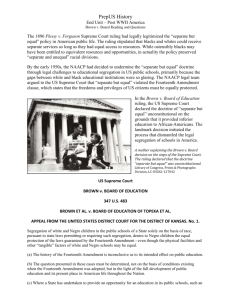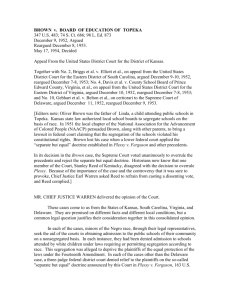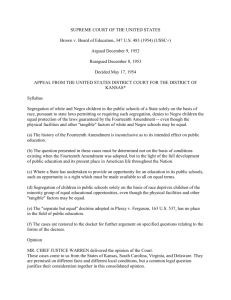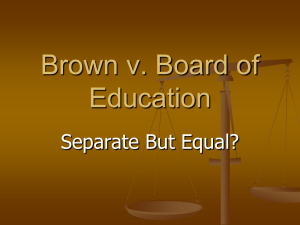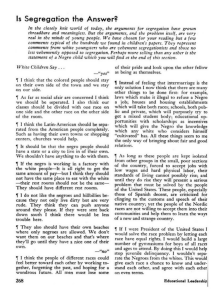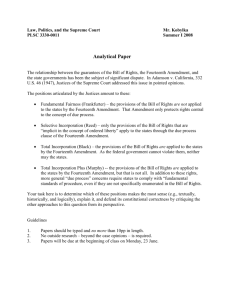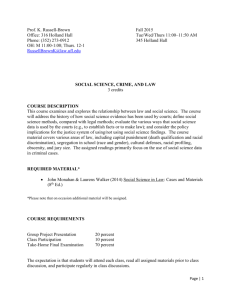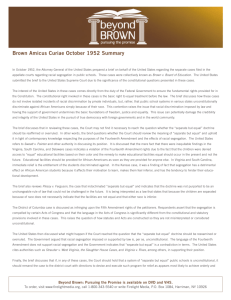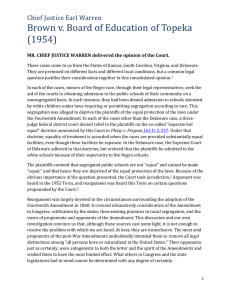1 BROWN v. BOARD OF EDUCATION 347 U.S. 483 (1954) (Argued
advertisement
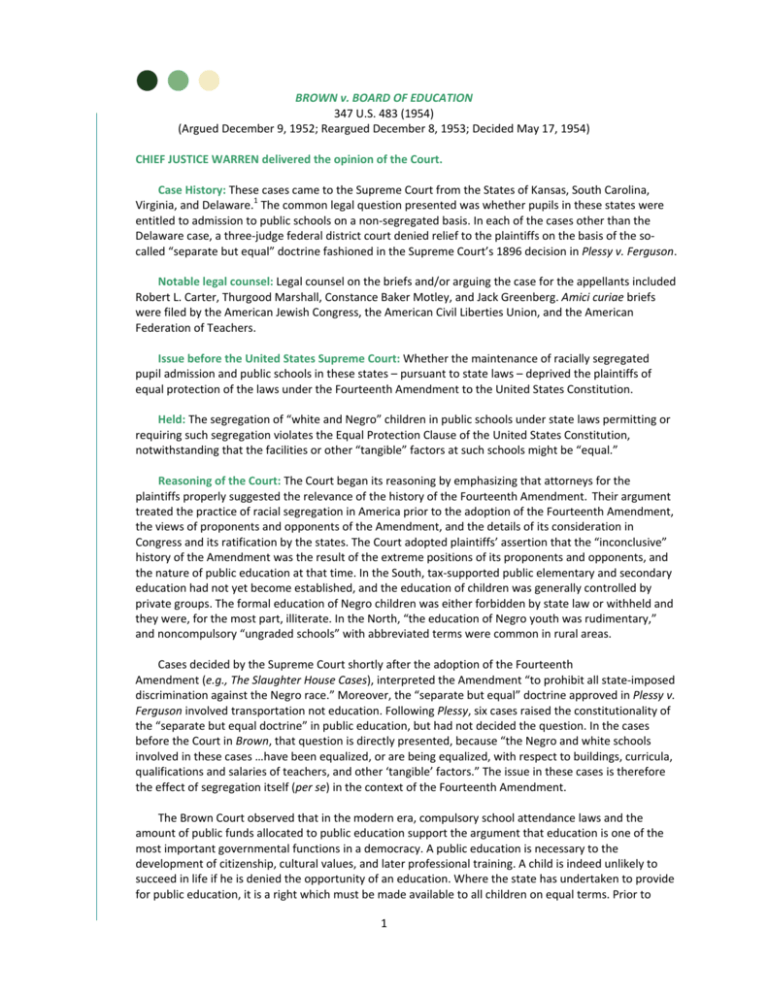
BROWN v. BOARD OF EDUCATION 347 U.S. 483 (1954) (Argued December 9, 1952; Reargued December 8, 1953; Decided May 17, 1954) CHIEF JUSTICE WARREN delivered the opinion of the Court. Case History: These cases came to the Supreme Court from the States of Kansas, South Carolina, 1 Virginia, and Delaware. The common legal question presented was whether pupils in these states were entitled to admission to public schools on a non-segregated basis. In each of the cases other than the Delaware case, a three-judge federal district court denied relief to the plaintiffs on the basis of the socalled “separate but equal” doctrine fashioned in the Supreme Court’s 1896 decision in Plessy v. Ferguson. Notable legal counsel: Legal counsel on the briefs and/or arguing the case for the appellants included Robert L. Carter, Thurgood Marshall, Constance Baker Motley, and Jack Greenberg. Amici curiae briefs were filed by the American Jewish Congress, the American Civil Liberties Union, and the American Federation of Teachers. Issue before the United States Supreme Court: Whether the maintenance of racially segregated pupil admission and public schools in these states – pursuant to state laws – deprived the plaintiffs of equal protection of the laws under the Fourteenth Amendment to the United States Constitution. Held: The segregation of “white and Negro” children in public schools under state laws permitting or requiring such segregation violates the Equal Protection Clause of the United States Constitution, notwithstanding that the facilities or other “tangible” factors at such schools might be “equal.” Reasoning of the Court: The Court began its reasoning by emphasizing that attorneys for the plaintiffs properly suggested the relevance of the history of the Fourteenth Amendment. Their argument treated the practice of racial segregation in America prior to the adoption of the Fourteenth Amendment, the views of proponents and opponents of the Amendment, and the details of its consideration in Congress and its ratification by the states. The Court adopted plaintiffs’ assertion that the “inconclusive” history of the Amendment was the result of the extreme positions of its proponents and opponents, and the nature of public education at that time. In the South, tax-supported public elementary and secondary education had not yet become established, and the education of children was generally controlled by private groups. The formal education of Negro children was either forbidden by state law or withheld and they were, for the most part, illiterate. In the North, “the education of Negro youth was rudimentary,” and noncompulsory “ungraded schools” with abbreviated terms were common in rural areas. Cases decided by the Supreme Court shortly after the adoption of the Fourteenth Amendment (e.g., The Slaughter House Cases), interpreted the Amendment “to prohibit all state-imposed discrimination against the Negro race.” Moreover, the “separate but equal” doctrine approved in Plessy v. Ferguson involved transportation not education. Following Plessy, six cases raised the constitutionality of the “separate but equal doctrine” in public education, but had not decided the question. In the cases before the Court in Brown, that question is directly presented, because “the Negro and white schools involved in these cases …have been equalized, or are being equalized, with respect to buildings, curricula, qualifications and salaries of teachers, and other ‘tangible’ factors.” The issue in these cases is therefore the effect of segregation itself (per se) in the context of the Fourteenth Amendment. The Brown Court observed that in the modern era, compulsory school attendance laws and the amount of public funds allocated to public education support the argument that education is one of the most important governmental functions in a democracy. A public education is necessary to the development of citizenship, cultural values, and later professional training. A child is indeed unlikely to succeed in life if he is denied the opportunity of an education. Where the state has undertaken to provide for public education, it is a right which must be made available to all children on equal terms. Prior to 1 Brown, the Court rejected the “separate but equal” doctrine in cases involving law schools and graduate education, finding that it denies a Negro student the opportunity to study and exchange views with other students, and to learn his profession.2 Even more so at the elementary and secondary level, the separation of school children solely because of their race “…generates a feeling of inferiority as to their status in the community that may affect their hearts and minds in a way unlikely ever to be undone.” This sense of inferiority, the Court held – borrowing language from a prior case – “affects the motivation of a child to learn.”3 The Supreme Court concludes that, “… in the field of public education, the doctrine of ‘separate but equal’ has no place, [and that] separate educational facilities are inherently unequal” under the Equal Protection Clause of the Fourteenth Amendment. Further argument: The Court ordered further argument on the issue of the implementation of its decision requiring the desegregation of the public schools in the affected states (See Brown II below). [Consider, as you examine Brown II, and then the decisions that followed Brown, the basic observation of Professor Jack Bass that the Fifth Circuit’s decisions implementing Brown reveal a doctrine of “affirmative duties,” which shifted the burden to school boards to disestablish dual systems of public education and take affirmative action to overcome the effects of past discrimination based on race]. ______________________________________________ 1 Brown is consolidated with Briggs et al. v. Elliott et al., on appeal from the United States District Court for the Eastern District of South Carolina; Davis et al. v. County School Board of Prince Edward County, Virginia, et al., on appeal from the United States District Court for the Eastern District of Virginia, and Gebhart et al. v. Belton et al., on certiorari to the Supreme Court of Delaware. 2 Citing Sweatt v. Painter and McLaurin v. Oklahoma State Regents. 3 The Court’s critical observation about the effects of segregation of students on the ability of a Negro child to learn is supported by citation to modern education authorities, including: K. B. Clark, “Effect of Prejudice and Discrimination on Personality Development” (Mid-century White House Conference on Children and Youth, 1950); Witmer and Kotinsky, “Personality in the Making” (1952); Deutscher and Chein, “The Psychological Effects of Enforced Segregation: A Survey of Social Science Opinion,” 26 J. Psychol. 259 (1948); Chein, “What are the Psychological Effects of Segregation Under Conditions of Equal Facilities?” 3 Int. J. Opinion and Attitude Res. 229 (1949); Brameld, “Educational Costs, in Discrimination and National Welfare” (MacIver, ed., (1949); Frazier, “The Negro in the United States” (1949); and the Court cites generally the seminal work by G. Myrdal, “An American Dilemma.” Brown, et al. v. Board of Education of Topeka, et al. 349 U.S. 294; 75 S. Ct. 753 (1955) In May, 1955, Justice Warren, again writing for a unanimous Court, considered the question left unanswered in Brown I, and concerning which further arguments had been requested: “[The] manner in 1 which relief would be accorded.” Warren’s stated justification for consideration of the question was that the cases considered in Brown I “arose under different local conditions” and presented “a variety of local problems.” The Court’s opinion in Brown II reaffirmed its decision in Brown I that state enforced mandates sustaining racially segregated public schools violated the Fourteenth Amendment, and asked: (a) whether “Negro children should forthwith be admitted to schools of their choice”; (b) whether the Court’s equity powers permitted an “effective gradual adjustment” of existing segregated schools “to a system not based on color distinctions?” (emphasis added); (c) whether the Court should formulate “detailed 2 decrees” addressing “specific issues?”; and whether the Court remand the special decree responsibility to the lower (three judge) courts? In responding to these issues, Justice Warren’s opinion noted ab initio, that “substantial steps to eliminate racial discrimination in public schools have already been taken, not only in some of the communities in which these cases arose, but in some of the states appearing as amici curiae, and in other states as well.” Then, in language that would arguably diminish the significance of Brown I, the Chief Justice reasoned that “implementation of [the Constitutional principles of Brown I] “may require solution of varied local school problems.” If this is so, Warren observed, “school authorities have the primary responsibility for elucidating, assessing, and solving these problems; courts will have to consider whether the action of school authorities constitutes good faith implementation of the governing constitutional principles. Because of their proximity to local conditions and the possible need for further hearings, the [three judge] courts which originally heard these cases can best perform this judicial appraisal.” Although Justice Warren emphasized the need for compliance with the Constitutional principles announced in Brown I, explicitly reaffirming the public interest in the elimination of racial segregation in public schools, his opinion used arguably vague language requiring “a prompt and reasonable start toward full compliance [with Brown I]” – and demanded only that the defendant school boards “…establish that [their timetables were] necessary in the public interest and…consistent with good faith compliance at the earliest practicable date” [explicitly permitting the consideration of school plants, school transportation systems, personnel, revision of school districts and attendance areas (for purposes of admission of students on a non-racial basis), and time needed for revision of local laws and regulations]. The opinion ended with the language that would become the basis for southern resistance: That the transition from racially segregated public schools to the operation of public schools on a nondiscriminatory basis would occur with “all deliberate speed.” ______________________________________________ 1 The Department of Justice, and the Attorneys General of the states of Florida, North Carolina, Arkansas, Oklahoma, Maryland and Texas filed briefs and participated in oral argument. ◊◊◊ 3
